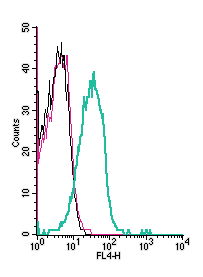Overview
- Peptide KDYPASTSQDSFEA(C), corresponding to amino acid residues 263-276 of human KV1.3 (Accession P22001). Extracellular loop between domains S1 and S2.

 Western blot analysis of rat brain membranes:1. Anti-KV1.3 (KCNA3) (extracellular) Antibody (#APC-101), (1:500).
Western blot analysis of rat brain membranes:1. Anti-KV1.3 (KCNA3) (extracellular) Antibody (#APC-101), (1:500).
2. Anti-KV1.3 (KCNA3) (extracellular) Antibody, preincubated with Kv1.3/KCNA3 (extracellular) Blocking Peptide (#BLP-PC101). Western blot analysis of human Jurkat T cells:1. Anti-KV1.3 (KCNA3) (extracellular) Antibody (#APC-101), (1:200)
Western blot analysis of human Jurkat T cells:1. Anti-KV1.3 (KCNA3) (extracellular) Antibody (#APC-101), (1:200)
2. Anti-KV1.3 (KCNA3) (extracellular) Antibody, preincubated with Kv1.3/KCNA3 (extracellular) Blocking Peptide (#BLP-PC101).
- Human lung carcinoma cell line A549 isolated nuclei (Jang, S.H. et al. (2015) J. Biol. Chem. 290, 12547.).
- Mouse retina (1:200) (Cangiano, L. et al. (2007) PLoS ONE 2, 1327.).
- Human B-cell lymphoma cells (Raji cells), (1:100) (Kawano, T. et al. (2009) Biol. Pharm. Bull. 32, 345.).
 Cell surface detection of KV1.3 by indirect flow cytometry in live intact human Jurkat T-cell leukemia cells:___ Cells.
Cell surface detection of KV1.3 by indirect flow cytometry in live intact human Jurkat T-cell leukemia cells:___ Cells.
___ Cells + goat-anti-rabbit-APC.
___ Cells + Anti-KV1.3 (KCNA3) (extracellular) Antibody (#APC-101), (5μg) + goat-anti-rabbit-APC.- Human T cells (Beeton, C. et al. (2006) Proc. Natl. Acad. Sci. U.S.A. 103, 17414.).
- The blocking peptide is not suitable for this application.
 Cell surface detection of KV1.3 by indirect flow cytometry in live intact human THP-1 monocytic leukemia cells:___ Cells.
Cell surface detection of KV1.3 by indirect flow cytometry in live intact human THP-1 monocytic leukemia cells:___ Cells.
___ Cells + goat-anti-rabbit-FITC.
___ Cells + Anti-KV1.3 (KCNA3) (extracellular) Antibody (#APC-101), (2.5μg) + goat-anti-rabbit-FITC.
 Expression of KV1.3 in HEK 293 transfected cellsCell surface detection of KV1.3 in live intact HEK 293 cells transfected with rat KV1.3 (panels A and C) or with empty vector (panels B and D) using Anti-KV1.3 (KCNA3) (extracellular) Antibody (#APC-101), (1:50).
Expression of KV1.3 in HEK 293 transfected cellsCell surface detection of KV1.3 in live intact HEK 293 cells transfected with rat KV1.3 (panels A and C) or with empty vector (panels B and D) using Anti-KV1.3 (KCNA3) (extracellular) Antibody (#APC-101), (1:50).
Staining (green) shows expression of KV1.3 in the transfected cells (A) but not in the cells transfected with empty vector (B). Panels C and D show the corresponding live image of the cells.
- Chandy, K.G. et al. (2001) Toxicon 39, 1269.
- Koo, G.C. et al. (1997) J. Immunol. 158, 5120.
KV1.3 belongs to the Shaker family of voltage-dependent K+ channels. The channel, encoded by KCNA3, is widely expressed in the brain, lung and osteoclasts and in several cell populations of hematopoietic origin. The prominence of KV1.3 channels in these cells (particularly in T lymphocytes) directed much research attention. It was found that KV1.3 is the main channel responsible for maintaining the resting potential in quiescent cells and regulating the Ca2+ signaling that is indispensable for normal T lymphocyte activation.1,2 Based on the central role of KV1.3 in regulating the initiation of an immune response, the channel has been recognized as a potential target for immunosuppressant drugs.1 The central role of KV1.3 in immune system cells created a real need for a specific antibody that would be able to work in flow cytometry applications.
Application key:
Species reactivity key:
Anti-KV1.3 (KCNA3) (extracellular) Antibody (#APC-101) is a highly specific antibody directed against an extracellular epitope of the human protein. The antibody can be used in western blot, immunohistochemistry, live cell imaging and indirect flow cytometry applications. It has been designed to recognize KV1.3 potassium channel from human, mouse and rat samples.
Applications
Citations
- Immunocytochemistry of mouse bone marrow-derived neutrophils. Tested in Kv1.3 -/- mice.
Immler, R. et al. (2022) Cardiovasc. Res. 118, 1289.
- Human Jurkat cell lysate.
Szabo, I. et al. (2015) Cell. Physiol. Biochem. 37, 965. - Human lung carcinoma cell line A549 isolated nuclei.
Jang, S.H. et al. (2015) J. Biol. Chem. 290, 12547. - Human lymphomas (1:200).
Vallejo Gracia, A. et al. (2013) J. Leukoc. Biol. 94, 779. - Human B-CLL cells.
Leanza, L. et al. (2013) Leukemia 27, 1782. - Human Jurkat T-cells (1:300).
Sanchez Miguel, D.S. et al. (2013) Biochem. Biophys. Res. Commun. 434, 273.
- Human lung carcinoma cell line A549 isolated nuclei.
Jang, S.H. et al. (2015) J. Biol. Chem. 290, 12547.
- Mouse cerebral cortex.
Duque, A. et al. (2013) Develop. Neurobiol. 73, 841. - Human lymphomas (1:70).
Vallejo Gracia, A. et al. (2013) J. Leukoc. Biol. 94, 779. - Human acute T-lymphoblastic lymphomas (1:300).
Sanchez Miguel, D.S. et al. (2013) Biochem. Biophys. Res. Commun. 434, 273. - Mouse retina (1:200).
Cangiano, L. et al. (2007) PLoS ONE 2, 1327.
- HEK 293 transfected cells.
Jimenez-Perez, L. et al. (2016) J. Biol. Chem. 291, 3569. - Human umbilical vascular endothelial cells (HUVECs) (1:100).
Yang, L. et al. (2013) Toxicol. Lett. 223, 16. - Mouse leukaemia monocyte macrophage cells (raw 264.7), human Jurkat T-cells, human Raji B-lymphocytes.
Vallejo Gracia, A. et al. (2013) J. Leukoc. Biol. 94, 779. - Human B-cell lymphoma cells (Raji cells), (1:100).
Kawano, T. et al. (2009) Biol. Pharm. Bull. 32, 345.
- Human T cells.
Beeton, C. et al. (2006) Proc. Natl. Acad. Sci. USA 103, 17414.
- Hajdu, P. et al. (2015) Mol. Biol. Cell 26, 1640.
- Gazula, V-R. et al. (2010) J. Comp.Neurol. 518, 3205.
- Vicente, R. et al. (2008) J. Biol. Chem. 283, 8756.
